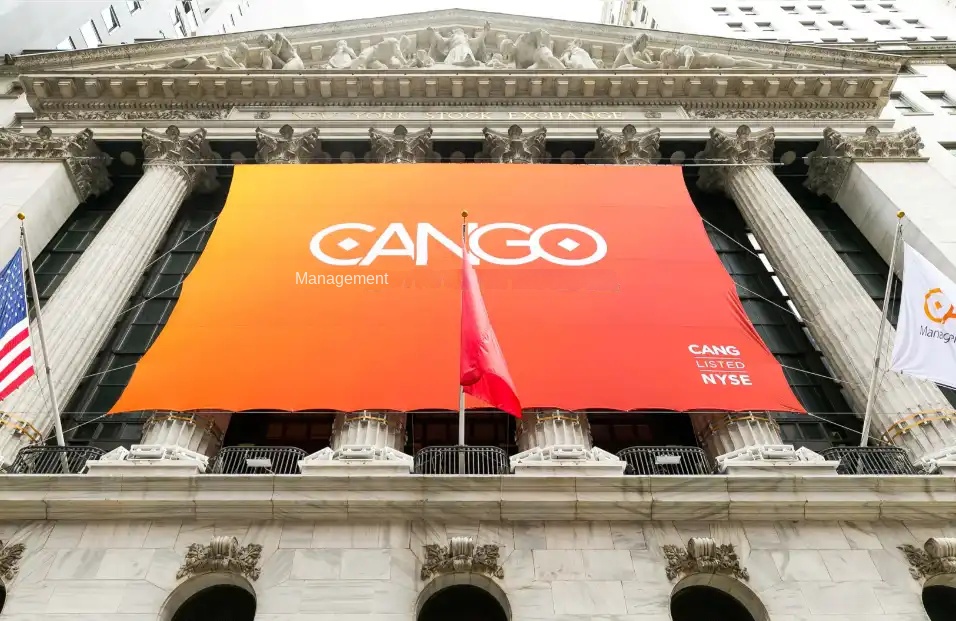CanGu, an Underrated Eastern Microstrategy

CanGu (NYSE:CANG), this is an undervalued "Eastern MicroStrategy".
This round of "MicroStrategy-ization" has swept through the capital markets: putting Bitcoin on the balance sheet, along with the narrative of "long-termism + capital tool," indeed can earn a pricing premium. But the script is too easy to copy, and the market is flooded with numerous imitators who are all talk and no action—leading with slogans in announcements, yet providing vague details about actual holdings, let alone clear disclosure or a closed-loop of funds: lacking defined refinancing and risk control arrangements, as well as verifiable data rhythms.
The result is that "more and more storytelling companies emerge, but those truly solidifying their balance sheets are few."
In distinguishing between "storytelling" and "substance," in the author's view, companies worthy of investment in the "MicroStrategy-style" must have the following characteristics: embedding long-term holding in corporate governance, utilizing capital market tools (such as issuance/convertible bonds, etc.) as disciplined expansion methods, high-frequency, transparent financial reporting, and maintaining a solid cash flow. Only when these three aspects resonate in harmony will the narrative premium settle into a cycle-resistant balance sheet, rather than a bubble that collapses as soon as the market retreats.
And CanGu has perfectly hit these points.
Looking Back on CanGu's "Transformation" Path
If you straighten the timeline, you'll find that this is not a "chase-the-rise buy Bitcoin" performance but a planned, step-by-step corporate transformation. Beginning with divestment, then consolidation, first establishing production capacity stability, and then using monthly disclosures to establish holding rhythms, finally solidifying coordination through governance adjustments.
On November 6, 2024, CanGu first announced and then completed the cash acquisition of 32 EH/s of on-shelf mining machines (the seller being a Bitmain related entity) and simultaneously disclosed the acquisition of an additional 18 EH/s of on-shelf mining machines through stock issuance (i.e., the equity settlement portion completed later on June 27, 2025). This was its entry point into the crypto mining business. That month, CanGu mined 363.9 BTC, and in December, 569.9 BTC, all of which were not sold, marking CanGu's earliest form of "MicroStrategy-style BTC hoarding."
By 2025, governance was another key focus for CanGu.
One of the most significant moves was on May 27, when the company disposed of its entire mainland stock business, selling it to Ursalpha Digital Limited for a cash consideration of approximately $351.94 million, proactively separating the revenue of the old model from the risk of the new strategy, leaving historical burdens behind. From then on, capital and disclosure were fully aligned with the central axis of "Bitcoin mining + BTC asset management."
The expansion of mining capacity is not achieved through "buying spot and telling stories," but by directly incorporating "on-shelf mining machines." Therefore, following that, on June 27, Cany Valley completed the delivery of encrypted mining machine assets through equity settlement, consolidating 18 EH/s of hash rate in one go, with the consideration being the issuance of 146,670,925 shares of Class A common stock to the seller; among them, Golden TechGen Limited (GT) became a significant shareholder, holding approximately 19.85% of the shares, with the sellers collectively holding about 41.38%. This "exchange of shares for production capacity" transaction sends two key signals: first, most of the machines are located in data centers in various countries, with delivery already in production, thus reducing the time loss of "buying equipment—powering up—ramping up"; second, the production capacity immediately becomes the hard foundation of the balance sheet, providing a sustainable source of "internally generated BTC" for subsequent monthly disclosures and inventory strategies.

Once the production capacity was in place, the operational rhythm immediately became apparent. The July disclosure showed that Cany Valley's deployed hash rate had reached 50 EH/s, with an average monthly operating hash rate of 40.91 EH/s, resulting in a monthly output of 650.5 BTC, a 45% increase month-on-month; end-of-period inventory increased to 4,529.7 BTC. The significance of this set of data lies not only in "speeding up" but also in the caliber and frequency of disclosures: the company synchronously updates along the four lines of "output/deployment/monthly average/inventory," laying out the closed loop of "capacity—output—inventory" in the sunlight, providing investors with an operational dashboard that can be "monthly reconciled." The management also explicitly stated that they "do not intend to sell" the held bitcoins, with the HODL attitude and rhythm being included in the external discourse.
At the governance level, the shift, along with production capacity and disclosure, progressed in synchrony. On July 23, the company announced the completion of a secondary equity transaction and board reorganization: Antalpha's founder Moore Xin Jin as Chairman of the Board, Paul Yu as CEO, Michael Zhang as CFO, Simon Tang as CIO, among others. On the one hand, the control structure and management team were aligned in one go, leaving sufficient organizational depth for the synergy among the "capacity side—capital side—power side"; on the other hand, strategic partnerships were reached with key industry participants including Bitmain and Antalpha, implying that Cany Valley has a greater industrial synergy space and bargaining power in terms of mining machine supply, asset management, and even energy investment. For a company following an "asset-driven" path, such an industrial capital alliance translates external uncertainty into a manageable internal resource.

Sun Valley Company Announces Completion of Second Acquisition and Appointment of New Management Team
Pricing Discrepancy: Why Was Sun Valley Undervalued?
Let's first look at the originator of the "HODL Stock" concept, MicroStrategy: In fact, MicroStrategy's greatest competitive advantage lies in its strong capital base, which allows it to raise money in the market. However, its ability for self-owned production is almost non-existent. If you ask people around you who know about MicroStrategy, the vast majority of them are unaware of MicroStrategy's core business. Sun Valley, on the other hand, has the advantage of self-owned production capacity and an internal engine, namely continuous mining with mining machines, reducing its sensitivity to simply expanding its balance sheet through financing.
Looking at more intuitive premium data, it currently holds 628,791 BTC, corresponding to an mNAV≈1.68x. In other words, the market is willing to give it an additional 68% premium on top of the Bitcoin net asset value to price its financing ability and the sustainability of its "long-term HODL" strategy.
Let's apply the same yardstick to Sun Valley. By July 2025, Sun Valley's monthly disclosure shows: holding 4,529.7 BTC in inventory, 650.5 BTC mined in the month, deployed hashrate of 50 EH/s, average monthly operational hashrate of 40.91 EH/s, and the company clearly stating that it "currently has no plans to sell." Based on a rough calculation using Bitcoin's price of approximately $114,165 on August 6, Sun Valley's BTC holdings are worth about $517 million. The market value disclosed on its official website is approximately $833 million, with a stock price of around $4.70–$4.73. This means that Sun Valley's "BTC Premium Coverage" is only ~1.61x ($8.33B/$5.17B), close to MSTR's ~1.68x, not to mention that most current "MicroStrategy-style" companies have premium rates between 3-10x.
However, unlike MSTR, Sun Valley also has its own 50 EH/s hashrate engine. With the same "HODL Premium," but overlaid with the internal cash flow of "in-hand production capacity," this is the first piece of evidence of why it is "undervalued."
Comparing this to Japan's Metaplanet, which enjoys the tax and investor structure benefits in Japan but lacks the deeper liquidity of the U.S. stock market, to some extent, it has a higher possibility of a short-selling crisis by larger institutions. Sun Valley, on the other hand, has taken the U.S. stock market path, with higher disclosure frequency, deeper liquidity, and the combination of hashrate and financial statements, making the capital participation threshold and expected management more transparent.
As for comparing it to traditional "pure mining companies," Sun Valley has even more advantages. We all know that mining companies are inherently profitable, which is why the last wave of cryptocurrency company IPOs was dominated by mining companies going public.

However, after several cycles, the traditional mining enterprises mostly still follow the "mine-sell-scale up production" model, resulting in higher passive exposure to the coin price. On the other hand, Canaan has adopted a transparent HODL policy, combined with capital actions such as "equity settlement and production expansion," moving itself from the paradigm of "selling mined assets for cash flow" to an asset operator that "strengthens its balance sheet with BTC." This positive spiral is expected to be healthier for the company.
Similarly, looking at intuitive data and comparing Canaan's market value to its hash rate, we get a rough estimate indicator of "Market Cap / EH/s": with $833 million market cap and 50 EH/s, it's approximately $16.65 million / EH/s. Assuming a monthly average operating hash rate of 40.91 EH/s, it's only $20.35 million / EH/s. Contrasting these figures with two leading North American companies: Riot, with 35.5 EH/s deployed at the end of July and a market cap of about $41-42 billion, corresponds to $1.06-1.16 billion / EH/s; Marathon, with a market cap of about $57-59 billion and a recent "energized hashrate" around ~54 EH/s, corresponds to $1.06-1.09 billion / EH/s. In the same field and magnitude, Canaan's unit hash rate pricing is only about 1/5-1/7 of the leading companies, falling into the undervalued range.
Furthermore, looking at the mining machine queue and efficiency, Canaan has provided an efficiency measure in its annual report and information documents: the average fleet energy efficiency is about 21.6 J/TH, and in Q4/2024, the unit hash rate output briefly reached 17.81 BTC/EH/s, with about 90% of the cluster being Bitmain water-cooled models. This means that at the same electricity price, its "electricity to coin" efficiency is not at a disadvantage. With "energy efficiency" and "geographical diversification" (sites in the United States, East Africa, Oman, Paraguay, etc.) combined, Canaan has enough room on the electricity cost curve to further lower the unit BTC full cost, which will widen the gap with its peers during a bear market.

Canaan's Next Steps
What truly supports the valuation is not just a change of buzzwords but rather building a "thick" and "stable" balance sheet.
Looking back at Canaan from this "first principles" perspective, it operates Bitcoin as a company-level strategic reserve: the management clearly states in public disclosures that they "do not intend to sell," in line with monthly disclosures of capacity, output, and inventory rhythms, transforming HODL from an attitude into an institutional practice that can be repeatedly verified by the market.
The key to long-termism lies not in how long you shout, but in allowing the market to reconcile monthly — each time an investor opens a disclosure, what they see is not just the price fluctuation, but rather inventory growth, steady operational capacity, and a governance structure underpinning it all. This approach of "entrusting uncertainty to the process and embedding certainty into the reports" is the essence of navigating through cycles.
Mining abides by a simple rule: electricity cost is the top variable. Whoever can lock in a low electricity price with renewable energy in a broader region and in a more long-term stable manner can drive down the "full cost" of a unit of BTC further in a bear market. Canaan's new board and management team, with their combined background in mining, finance, and energy investments, have the capability to close the loop on "electricity cost — capacity — holdings — financing."
Canaan's next step may be to continue adjusting the upper limit decision on the "power side" vertically. This could involve securing long-term power contracts and demand response in North America, utilizing excess energy and green energy credits in the Middle East, identifying cost advantages and flexible power structures in South America, East Africa, and other regions, while leveraging expertise in computing power and energy operations to gradually provide HPC computing power infrastructure services for AI companies, thus opening up a second growth curve for the enterprise. The front end is the deployment of computing power, the back end is the steady growth of the balance sheet, and in between lies the synergy of power contracts, operational efficiency, and capital tools.
However, vertical integration of mining does not aim for a one-time accomplishment but rather gradually sinks in a project cluster manner, turning "low electricity price + high uptime rate + replicable operation" into scalable organizational capability. In a bear market, this determines the resilience radius; in a bull market, it determines the speed of expansion and the power of financing negotiation.
Speaking of this, perhaps we can all see by now that what Canaan truly wants to convey is not the story of "chasing the price increase and buying coins" but the story of "leveraging self-owned capacity to turn BTC into a balance sheet asset": mining machines bring intrinsic BTC cash flow, the disclosure system provides verifiable trust, and HODL turns long-termism into a corporate-level rule.
And this is precisely Canaan's realization of its own path in the narrative lineage of the "Eastern MicroStrategy."
Welcome to join the official BlockBeats community:
Telegram Subscription Group: https://t.me/theblockbeats
Telegram Discussion Group: https://t.me/BlockBeats_App
Official Twitter Account: https://twitter.com/BlockBeatsAsia
 Forum
Forum

 Finance
Finance
 Specials
Specials
 On-chain Eco
On-chain Eco
 Entry
Entry
 Podcasts
Podcasts
 Activities
Activities
 OPRR
OPRR








